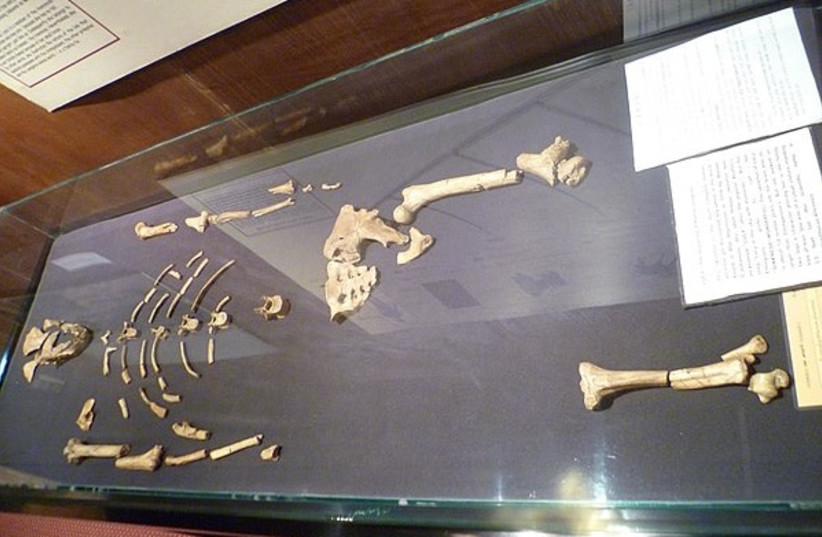Scientists have long been puzzled by the question of humanity's earliest ancestors and the way in which we evolved from tree-dwelling primates to become who we are today - Homo Sapiens.
One such question that paleontologists have been working to answer is that of how we came to walk on two legs rather than four, a phenomenon that has long marked hominins apart from the rest of the Great Apes.
Now, new research has shed light on the way in which bipedalism evolved millions of years ago, proving that while our earliest ancestors certainly didn't talk like us, they did walk like us.
The study, conducted by Dr. Ashleigh L.A. Wiseman of Cambridge University’s McDonald Institute for Archaeological Research and published in the peer-reviewed journal The Royal Society, examines the evolution of bipedalism - the ability to walk upright - through turning to one of the most famous early human ancestors, the Australopithecus Afarensis known as Lucy.
Lucy - humanity's most famous ancestor
Lucy is comprised of several hundred fragments of fossilized bone which, when combined, make up the skeletal structure of about 40% of the female body of the hominin species Australopithecus Afarensis.

The species dates back to some 2.3 million years ago and although thought to have been ape-like in appearance with a smaller brain, they had already developed the same ability to walk upright that humans have today.
"Lucy likely walked and moved in a way that we do not see in any living species today."
Dr. Ashleigh L.A. Wiseman
However, while scientists agree that Lucy and the rest of her species walked upright, they disagree when it comes to how exactly she did this, and what this looked like.
According to Wiseman, some scientists have long believed that the Australopithecus Afarensis walked in a crouching waddle, similar to chimpanzees, while others believed that they walked entirely upright, similar to Homo Sapiens.
Now, through a digital reconstruction of the hominin's lower body muscles, Wiseman hopes to put the debate to rest once and for all.
Recreating long-lost muscle mass
In order to reconstruct the soft tissue composition of Lucy's body, Wiseman used a method known as digital polygonal muscle modeling, in which a three-dimensional model of each muscle in a body segment is re-created, guided by comparative data from similar, still existing species.
Once each segment has been re-created, the entire "attachment site" that connects each segment is also re-created. The various segments are then connected by threading a line through the midpoint of each new 3D muscle, creating a correctly configured muscular system for each limb.
In this instance, the extant species used for comparison was the Homo Sapien and the muscles were mapped using MRI and CT scans of the muscle and bone structures of a modern woman and man.

Wiseman then used existing virtual models of Lucy’s skeleton to rearticulate the joints, defining the axis from which each joint was able to move and rotate, replicating how they moved during life.
Using this method, Wiseman was able to successfully recreate 36 muscles in each leg, most of which were much larger and stronger, and occupied more space, than the leg muscles of a modern human.
Carving a path through human evolution
Most notably, major muscles in Lucy's calves and thighs were double the size of the muscles found in modern humans, and while muscles make up just 50% of the total mass in the modern human's thigh, with the rest being fat, they made up 74% of the Australopithecus thigh.
Another notable finding of the study was the way in which the early human ancestors' knees functioned, and their range of movement.
In order for humans to stand, the knee must extend, and it was observed that the knees of the Australopithecus Afarensis did just that. According to the study, the knee extensors of the species indicated that they could have, and probably did, walk and stand upright with an erect position of the knee, as humans do today.
However, Wiseman notes in the findings, it is unclear if upright walking was frequently practiced or if it was a rarer occurrence, and further research will be conducted to this end in the future.
The research also indicated that while Lucy's bipedalism was similar to humans in some ways, she was also likely to have had a range of movement types that humans today are not capable of.
"We are now the only animal that can stand upright with straight knees. Lucy’s muscles suggest that she was as proficient at bipedalism as we are, while possibly also being at home in the trees. Lucy likely walked and moved in a way that we do not see in any living species today, " Wiseman explains of the research findings.
"Australopithecus afarensis would have roamed areas of open wooded grassland as well as more dense forests in East Africa around 3 to 4 million years ago. These reconstructions of Lucy’s muscles suggest that she would have been able to exploit both habitats effectively."
